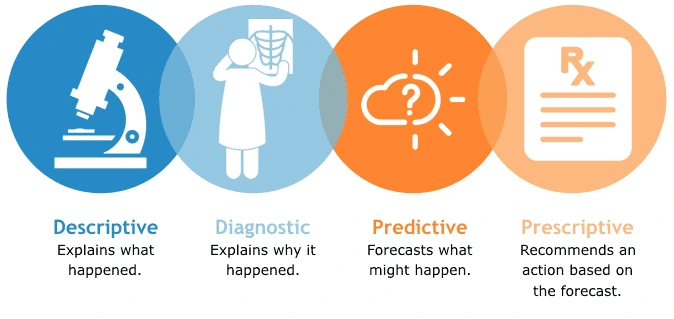In this article, we’ll explore four essential types of retail analytics that have the potential to change the way retailers operate and succeed in the dynamic landscape of 2025.

Descriptive analytics
Descriptive analytics is a powerful retail analytics method that organizes data to convey a comprehensive story about a business’s performance. It provides retailers with a valuable look into past and presents performance by combining data from various sources, including POS terminals, ERPs, inventory management systems, and more.
Purpose
The primary purpose of descriptive analytics is to offer retailers a performance summary of their business processes and actions. This type of analytics enables retailers to gain insights into critical aspects such as transaction history, inventory needs, and promotional successes. Moreover, it plays a vital role in gauging the effectiveness of direct mail campaigns by determining response and conversion rates, cost per acquisition, and customer lifetime value.
With the advent of big data analytics, retailers are leveraging advanced tools like Google Analytics to track website data, enabling them to understand traffic sources, page visits, time spent on specific pages; links opened, and more.
Descriptive analytics serves as the foundation of data insights, defining what is currently happening within a business. It compiles data from transactional history, promotional outcomes, and inventory changes to present a detailed summary of business activities. While retailers have utilized this type of analytics for a long time, the emergence of big data has allowed descriptive analytics to encompass multiple data points, including social media data, time spent on pages, link clicks, conversions, and engagement. It provides an elementary yet crucial form of retail analytics, visually representing past performances.
Examples/Use Cases
- Direct Mail Campaign Analysis: Retailers can employ descriptive analytics to measure the success of their direct mail campaigns by analyzing response rates, cost per lead, and conversion rates. This insight helps optimize future marketing strategies for improved customer engagement.
- Website Traffic Analysis: Using tools like Google Analytics, retailers can track and understand website traffic sources, user behavior, and page performance. This data can guide website optimization efforts to enhance user experience and boost conversion rates.
- Inventory Management: Descriptive analytics allows retailers to assess inventory changes over time, identifying trends in demand and optimizing stock levels to avoid overstocking or stockouts.
- Customer Lifetime Value: Retailers can use descriptive analytics to calculate the customer lifetime value by analyzing customer transaction history. This information helps in tailoring personalized marketing strategies to retain high-value customers.
Descriptive analytics provides a comprehensive picture of a business’s performance, serving as a starting point for further analysis. By understanding what has happened in the past and the current state of affairs, retailers can make data-driven decisions and set the stage for predictive and prescriptive analytics in their pursuit of retail success.
Diagnostics analytics

Diagnostic analytics empowers retailers to leverage data and find answers to the “why” behind specific business problems or opportunities based on two categories: discovery and alert. It is an enhanced descriptive analysis that compares relationships between variables and outcomes to uncover ongoing trends. It goes beyond descriptive analytics using advanced techniques such as statistical analysis, regression analysis, algorithms, and machine learning to dig deeper into datasets and identify trends, patterns, and relationships between variables. Diagnostic analysis helps uncover the underlying causes and relationships between data points, making it essential to understanding past performance and optimizing future strategies.
Purpose
The primary purpose of diagnostics analytics is to provide retailers with context and insights into the reasons behind specific outcomes. Diagnostics analytics uncovers ongoing trends and identifies potential issues by analyzing data and comparing the relationship between variables and outcomes. It enables retailers to answer questions like:
- Why did one promotional campaign succeed while another failed?
- What factors influenced a sales representative’s lower number of closed deals in a month?
- Are there any anomalies or outliers in the data that need attention?
Diagnostics analytics allows retailers to make data-driven decisions by establishing correlations between multiple variables and understanding what factors can be modified to achieve desired results.
Examples/Use Cases
- Promotion Performance Analysis: Retailers can use diagnostics analytics to compare the datasets of two different promotional campaigns and ascertain the reasons for their varying success. This insight can guide future marketing efforts to improve campaign effectiveness.
- Sales Representative Evaluation: Diagnostics analytics can help identify the factors influencing the performance of sales representatives. Retailers can analyze variables such as working days and vacation periods which lead to understanding the reasons behind changes in sales performance.
- Anomaly Detection: By leveraging diagnostics analytics, retailers can identify anomalies or potential issues in their data. For example, a sudden decrease in staff hours could be an alert for possible reduced closed deals, prompting retailers to take corrective actions.
- Talent Acquisition: Retailers can use diagnostics analytics to discover information about the most qualified candidates for new positions within the company. This insight ensures that the right talent is hired to enhance overall performance.
Diagnostics analytics complements descriptive analytics by adding context to the data and revealing the relationships between variables and outcomes. By examining past performance and understanding the reasons behind specific events, retailers can gain valuable insights to guide their business strategies and achieve success in the dynamic retail landscape.
Predictive analytics
Predictive analytics is an advanced data analytics category that builds on descriptive and diagnostic analysis findings to predict future outcomes. It involves the use of statistical techniques, algorithms, machine learning, and intelligent automation to predict trends, clusters, and outliers in data sets to predict trends. This is also the most commonly used type of data analytics by businesses.
With this type of prediction, which can usually be broken down into predictive and statistical models for a more multidimensional view, predictive analytics allows retailers to predict future trends and make informed decisions.
Purpose
Predictive analytics primarily empowers retailers to predict customer trends and behavior based on historical data and correlations identified by diagnostic analytics. By predicting future outcomes, predictive analytics enables retailers to plan and strategize in advance, gaining a competitive edge in a dynamic retail landscape. Retailers use predictive analytics to answer questions like:
- What products are likely to be popular in the upcoming season?
- How can we predict and prevent customer churn?
- What factors influence demand for certain products?
Predictive analytics enables retailers to optimize inventory, personalize marketing strategies, and enhance retention by providing valuable insights into future trends.
However, it is always an uncertain factor because it is a predictive analysis. Therefore, an accurate prediction requires correctly identifying the input data source, whether there are outliers in the data, and what conditions may arise that cause the forecast results to change.
Examples/Use Cases
- Demand Forecasting: Predictive analytics can analyze historical sales data and market trends to forecast future product demand. This insight lets retailers plan inventory levels and ensure product availability during peak seasons.
- Customer Churn Prediction: By using predictive analytics, retailers can identify customers at a higher risk of churn based on past behavior. This allows them to implement targeted retention strategies and prevent customer attrition.
- Personalized Marketing: Retailers can leverage predictive analytics to analyze customer data and predict individual preferences. This information enables customized marketing campaigns that enhance customer engagement and loyalty.
- Price Optimization: Predictive analytics helps retailers optimize pricing strategies by analyzing historical sales data and market trends. It enables retailers to set competitive prices while maximizing revenue.
Predictive analytics is essential for retailers seeking to stay ahead in the competitive market by foreseeing potential challenges and opportunities. By using advanced statistical methods, machine learning, and data mining, retailers can make accurate forecasts and informed decisions to achieve retail success.
Prescriptive analytics

Prescriptive analytics is a powerful type of retail analytics that takes predictive analytics further by suggesting the best course of action to achieve desired results. This is the final analysis phase in retail analytics. It will incorporate advanced algorithms, ML, big data, and simulation models to analyze data and suggest possible solutions.
And of course, this kind of analysis requires adequate documentation and commitment if it is to be carried out. Big names like Apple and Facebook are now seriously applying this type of analysis in their business. Regulatory analytics empowers retailers to make data-driven decisions by providing insights into capitalizing on opportunities, mitigating risk, and optimizing company ROI.
Purpose
The primary purpose of regulatory analysis is to guide retailers to make the most optimal decisions to achieve their business goals. By analyzing data from predictive analytics and considering various constraints, prescriptive analytics recommends specific actions that can lead to desired outcomes. Usually, the analysis results will be used to predict changes in consumer sentiment, buyers, supply shocks, etc. From there, it will help the administrator to make reasonable adjustments, such as:
- What pricing strategy should be adopted to maximize profits while remaining competitive?
- How to optimize inventory to minimize shipping costs while meeting customer needs?
- Which marketing and promotion channels should be prioritized to achieve the highest ROI?
- How should the product’s price be set to meet customers’ needs while maintaining competitiveness and ensuring revenue?
By providing actionable recommendations, regulatory analytics enables retailers to shape their strategies and operations for optimal performance proactively.
Examples/Use Cases
- Dynamic Pricing: Retailers can use prescriptive analytics to adjust prices based on demand, competitor pricing, and inventory levels. This enables them to find the ideal balance between maximizing profits and attracting customers.
- Inventory Optimization: Prescriptive analytics can optimize inventory levels by considering demand forecasts, lead times, and storage costs. Retailers can ensure they have the right products in stock at the right time without excessive carrying costs.
- Marketing Allocation: By leveraging prescriptive analytics, retailers can allocate their marketing budget across various channels and campaigns to achieve the highest return on investment. This ensures that marketing efforts are focused on the most effective strategies.
- Assortment Planning: Prescriptive analytics can guide retailers in determining the optimal assortment of products in their stores. By analyzing customer preferences, market trends, and profitability, retailers can curate assortments that resonate with their target audience.
Prescriptive analytics empowers retailers to make proactive and well-informed decisions, ensuring that resources are allocated optimally, and strategies are aligned with business objectives. By leveraging data-driven insights, retailers can gain a competitive advantage and enhance overall retail success.
Conclusion
As the retail industry evolves, data analytics will remain the driving force behind retail success. Embracing these four retail analytics types will set the stage for retailers to thrive in 2025 and beyond. So let’s embark on this data-driven journey together, where retailers can turn data into actionable insights, shape the future of retail, and map out Roadmap to unprecedented success.
Do you need help knowing where to start with retail analysis? Synodus is ready to assist!
More related posts from Big Data blog you shouldn’t skip:
- 9 Representative Retail Data Analytics Use Cases & Examples
- The Ultimate Guide Of Retail Analytics: Definition, Types And Examples Included
- Leveraging Predictive Analytics In Excel For Sales Forecasting: How To Do It
How useful was this post?
Click on a star to rate it!
Average rating / 5. Vote count:
No votes so far! Be the first to rate this post.




